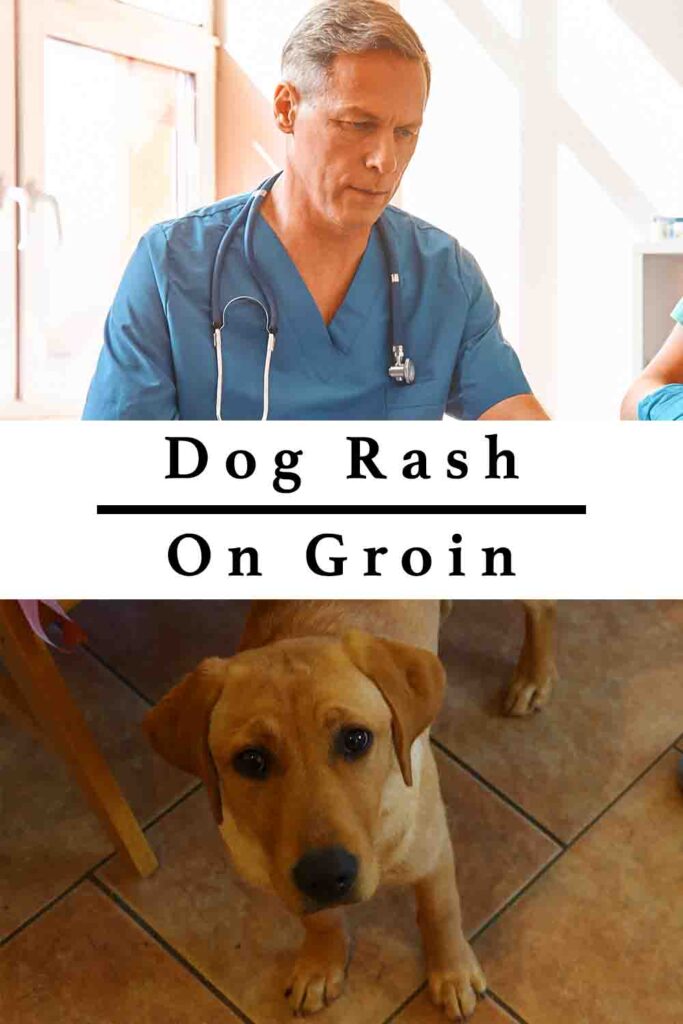A rash on the groin is a sensitive and uncomfortable matter for our dogs! Dogs can experience the same skin problems on their undercarriage that they suffer anywhere else on their body. Rashes can be brought on by bacterial or fungal infections, parasites, allergies, or atopic dermatitis. Groin rashes can be difficult to treat because the area is warm and traps moisture. Friction when the dog moves also irritates the skin and slows down healing. Here’s a primer on why dogs get groin rashes, and how to treat them.
Contents
- Causes of dog rash on groin area
- Why dogs are disposed to eczema around their crotch
- Treating a dog rash on the lower abdomen
Causes of dog rash on groin area
Lots of things can trigger rashes and eczema on dogs’ groins. They can be broadly categorized into:
- Bacterial infections
- Fungal infections
- Parasites
- Specific known allergies
- Atopic dermatitis

Bacterial infections
All dogs play host to a complex ecosystem of microorganisms all over their skin, including a ‘normal’ population of many types of bacteria. But, if a normally-present strain of bacteria explodes in numbers, or a new, disease-causing strain is introduced, it can upset the skin’s delicate balance. Symptoms of bacterial skin infections around the crotch include:
- A pimple-like rash known as pyoderma, which looks very similar to impetigo in human babies.
- Itching
- Flaking skin
- Hair loss
Fungal infections
Healthy canine skin also plays host to lots of normal fungal organisms as well. When they multiply out of control, it is known as yeast dermatitis, or sometimes Malassezia dermatitis after the strain of yeast usually responsible. The genital area is a common location for yeast dermatitis. Rash-like symptoms include:
- Thickening of the skin
- Scaly or crusty skin
- Redness
- Hyperpigmentation (darkening of the skin)
Fungal skin infections also tend to have a distinctive musty odor that sets them apart from other types of eczema.
Parasites
Parasites that infest a dog’s skin can also be the culprits behind a rash on their groin. The most common examples of this are flea allergy dermatitis, mange, and scabies.
Flea allergy dermatitis is when a pup’s immune system launches an over the top reaction to flea bites. Where the skin has been bitten, it turns red, develops acne-like lesions, and becomes intensely itchy. The most common sites for finding flea allergy dermatitis are around a dog’s groin, on their back at the base of their spine, and around their neck.
Mange and scabies are both caused by tiny mites that burrow into dogs’ skin to lay their eggs. When the larvae hatch, they start moving around under the skin, which causes unbearable itching. When a dog scratches or chews the area to relieve the itch, they break away the fur and damage the skin, creating sores and scabs. These symptoms most often appear around their pelvic region, ears, and shoulders.
Specific known allergies
Sometimes when dogs experience allergic reactions, it can cause a rash on their under carriage. We’ve already looked at one example of this – an extreme allergic reaction to flea bites. Another example is allergic contact dermatitis. Allergic contact dermatitis is when the skin launches an immune response because it has been touched by an allergen in the environment. Common culprits are:
- Perfumes
- Adhesives
- Rubber
- Carpets
- Household cleaning products
- Insecticides and fungicides
- Chemicals used in making and dyeing fabric and leather
- Cement
- Grass
Contact dermatitis starts off as itchy inflammation of the skin, but if the dog continuously scratches or chews it to relieve the itching, the skin can end up red, raw, broken and infected. Contact allergy rashes are especially likely to develop around a dog’s groin because the hair is sparser there. Elsewhere, the fur on their body acts like a barrier that prevents allergens from reaching the skin. The underside of their body, including the groin area, is also much more likely to come into contact with allergens from the ground!
Atopic dermatitis
Atopic dermatitis is one of the most commonly diagnosed and complex health problems in our pet dogs. It’s the doggy equivalent of eczema in humans. In affected pups, the skin becomes inflamed and stops working effectively as a barrier against the environment. Since the skin is no longer an efficient barrier, bacteria, fungi and allergens can all penetrate it and disturb it more easily. So dogs with atopic dermatitis are especially vulnerable to the bacterial and fungal infections and allergic reactions we’ve already looked at.
Atopic dermatitis has a high degree of heritability, meaning dogs are more likely to be affected if one or both parents had it. The main symptom is itching. Other symptoms, including a rash around the crotch, can appear as a result of atopic dermatitis letting bacterial and fungal infections or allergens into the skin.
Why dogs are disposed to eczema around their crotch
Most rash-causing ailments can occur anywhere on a dog’s body. But their belly and pelvic region are particular hot spots for skin problems. It’s especially warm down there, and it traps moisture for a long time after a wet walk or a swim – ideal conditions for bacteria and fungi to flourish! It’s also an area where the skin often comes into rubs against itself during exercise, which can make irritation worse. And, it’s relatively easy for our hounds to access. Dogs can ‘scratch’ an itch with their nails, or by licking and chewing at it. Their crotch is easily accessible for licking and chewing, which makes skin problems get worse.
Treating a dog rash on the lower abdomen
Any and all rashes on your dog ought to be seen by a veterinarian as soon as you spot them. Your vet will take a full medical history, and possibly perform tests like a skin scrape or a patch test to diagnose what’s causing the rash. Then they will help you plan a course of treatment.
Unlike in humans, rashes on dogs are rarely treated with topical medicines like creams or ointments. Firstly because it can be tricky to apply them to the skin through their fur. And secondly because they are prone to licking them straight back off again. Instead, your vet might suggest:
- Antipruritic medicines to block the itchy sensation.
- Anti-inflammatory medicines, to reduce skin inflammation.
- Antibiotics for pyoderma and other bacterial dermatitis outbreaks.
- Washing them with anti-fungal shampoo.
- Insecticide treatments to kill parasites.
- Putting a cone or inflatable collar on them to stop them scratching and give the skin a chance to heal.
Where allergies are suspected, your vet might also ask you to limit what your dog eats, or keep a diary of the places they go and the things they come into contact with, to try and identify a culprit. If a specific allergen is identified, it might be possible to reduce your dog’s sensitivity using immunotherapy.
Preventing future problems
Some groin rashes are a one-off event. Others are seasonal, and flare up every year – such as a contact dermatitis caused by grass pollen. Atopic dermatitis is a lifelong disease, and the focus is on preventing and managing flare ups, rather than curing it. There’s some evidence that supplementing their diet with extra fatty acids to aid skin barrier repair might decrease the frequency and severity of flare ups, for example. Depending on what caused your dog’s groin rash, you vet will likely make recommendations about how to prevent it recurring in future.
Dog rash on groin – summary
Rashes on a dog’s groin are uncomfortable, and sometimes difficult to treat because the area is relatively easy for the dog to reach and scratch. They can be caused by many things, so this is no time for guesswork. Visit a veterinarian as early as possible to identify the cause and plan an appropriate course of treatment. Your itchy dog will thank you for it!
The Labrador Site Founder
Pippa Mattinson is the best selling author of The Happy Puppy Handbook, the Labrador Handbook, Choosing The Perfect Puppy, and Total Recall.
She is also the founder of the Gundog Trust and the Dogsnet Online Training Program
Pippa's online training courses were launched in 2019 and you can find the latest course dates on the Dogsnet website



















